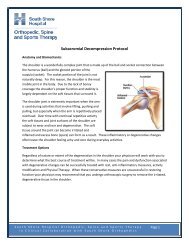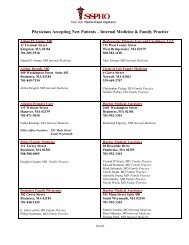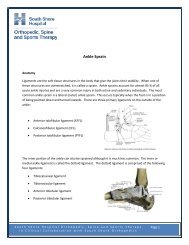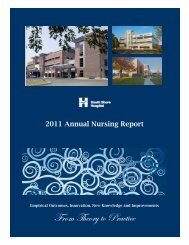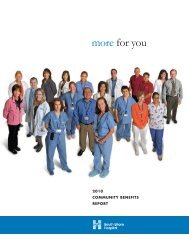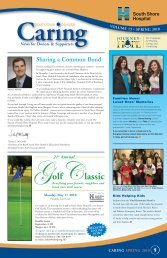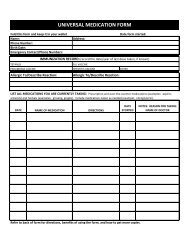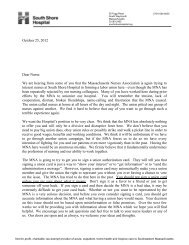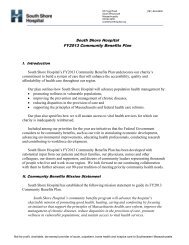SLAP Repair Protocol - South Shore Hospital
SLAP Repair Protocol - South Shore Hospital
SLAP Repair Protocol - South Shore Hospital
Create successful ePaper yourself
Turn your PDF publications into a flip-book with our unique Google optimized e-Paper software.
<strong>SLAP</strong> <strong>Repair</strong> <strong>Protocol</strong>Anatomy and BiomechanicsThe shoulder is a wonderfully complex joint that is made up of the ball and socket connection betweenthe humerus (ball) and the glenoid portion of the scapula (socket). The socket portion of the joint is notnaturally deep. For this reason the shoulder is the most mobile joint in the body. Due to the lack ofboney coverage the shoulder’s proper function and stability is largely dependent on the soft tissues thatsurround it.The glenoid labrum is a fibrocartilage rim that surrounds the edge ofthe glenoid fossa (socket). It serves to deepen the socket andprovide suction effect on the head of the humerus (ball), thusimproving the stability of the naturally shallow joint. The labrum canbe damaged or torn in many different ways. When the superior(upper) part of the labrum is torn it is often termed a <strong>SLAP</strong> tear. Thisacronym stands for superior labrum from anterior to posterior. A<strong>SLAP</strong> tear can happen traumatically or in response to repetitiveactivity like throwing.Treatment OptionsRegardless of how the labrum is torn your physician will work with you to determine what the bestcourse of treatment will be. In many cases the pain and dysfunction associated with a <strong>SLAP</strong> tear can besuccessfully treated with rest, anti-inflammatory measures, activity modification and Physical Therapy.When conservative measures are unsuccessful in restoring function you and your physician may elect tohave the torn labrum repaired.SurgeryLabral repair surgery involves re-anchoring or trimming the tornpiece of cartilage. The procedure is usually performedarthroscopically and is, in most cases an outpatient day surgeryprocedure. This means that it is very rare to have to spend thenight in the hospital. If damage to the labrum or other tissue isextensive your surgeon may have to use an open incision ratherthan an arthroscope to complete the procedure. Regardless, ofwhether the procedure is open or arthroscopic all patients will likely be home on the same day assurgery.<strong>South</strong> <strong>Shore</strong> <strong>Hospital</strong> Orthopedic, Spine and Sports Therapyin Clinical Collaboration with <strong>South</strong> <strong>Shore</strong> OrthopedicsPage 1
Recovery/Time off WorkRecovering from labral repair surgery is not easy. It is very important that the patient knows that therecovery process is difficult and time consuming. He or she must be an active participant during thisprocess, performing daily exercises to ensure there is proper return of range of motion and strength.There is a large amount of variability in the time it takes to fully recover from this procedure. It isusually estimated that it will take at least 4-6 months to feel as though you have completely regainedthe use of your arm. Some cases may take as long as 9-12 months to make a full recovery. People withdesk jobs should plan to take at least 1 week off from work. Manual laborers will likely be out of workfor at least 4-6 months. Recovery is different in each case. Your individual time table for return toactivities and work will be discussed by your surgeon during post operative office visits.Post Operative VisitsYour first post-op visit to the doctor’s office will be approximately 7-10 days after the operation. At thisvisit your stitches will be removed and you will review the surgery with the surgeon or his assistant. Atthis time you will most likely be cleared to make an appointment to begin Physical Therapy. You shouldalso plan to check in with your surgeon at 6, 12, and 24 weeks after the operation.At HomeYou may remove your post-op dressing 2 days after the operation and replace it as needed. Do notremove the strips of tape (steri-strips) that are across your incision. Allow them to fall off on their own.You may shower after 2 days, but use a water-tight dressing until your sutures are removed. Bathingwithout getting the shoulder wet or sponge baths are a good alternative. You may wash under theaffected arm by leaning forward and letting the arm dangle. Do not attempt to actively move your armat the shoulder joint for any reason until your doctor allows you. You may remove your sling severaltimes a day and gently move your hand, wrist and elbow and perform shoulder pendulum exercises.MedicationYour surgeon will prescribe pain medicine for you after the operation. Please call the doctor’s office ifyou have any questions regarding medication.IceYou must use ice on your shoulder after the operation for management of pain and swelling. Ice shouldbe applied 3-5 times a day for 10-20 minutes at a time. Always maintain one layer between ice and theskin. Putting a pillow case over your ice pack works well for this.SlingYou will be provided with a sling to wear after the operation. You should wear this sling most of thetime for at least the first 2 weeks after the operation. Remove it when bathing/showering, or to do yourexercises. Some patients may require the use of the sling for the first 4 weeks after the operation. Yourdoctor will give you specific instructions regarding how long you should use your sling.<strong>South</strong> <strong>Shore</strong> <strong>Hospital</strong> Orthopedic, Spine and Sports Therapyin Clinical Collaboration with <strong>South</strong> <strong>Shore</strong> OrthopedicsPage 2
SleepingYou may sleep with a pillow propped under your arm to keep it slightly away from the body. For manypatients lying flat is uncomfortable at first. It is generally easier to sleep propped up or in a recliner for ashort period of time after the operation. Do not attempt to sleep on your operated shoulder for at least6 weeks.<strong>South</strong> <strong>Shore</strong> <strong>Hospital</strong> Orthopedic, Spine and Sports Therapyin Clinical Collaboration with <strong>South</strong> <strong>Shore</strong> OrthopedicsPage 3
Rehabilitation**The following is an outlined progression for rehab. Time tables are approximate and advancementfrom phase to phase as well as specific exercises performed should be based on each individualpatient’s case and sound clinical judgment by the rehab professional. **Phase 1 (0-4 Weeks) Passive ROM PhaseGoalsControl Pain and SwellingProtect Healing TissueBegin to Restore Range of MotionPrecautionsDo not actively reach arm behind back.Do not actively reach overhead.Do not actively reach arm behind your head.Do not lift anything with your arm.Recommended Exercises*See passive ROM limitations in chart on page 8*PendulumsStanding Scapular Mobility (no resistance)Supine or Standing Passive External RotationSupine, Seated or Standing Passive Shoulder Flexion (elevation)Passive Internal RotationSub-maximal Isometric Shoulder Internal and External RotationBall SqueezeGuidelinesPerform these exercises 3-5 times a day. Do 1-2 sets of 10-20 repetitions of each exercise.Phase 2 (4-8 Weeks) Active ROM PhaseGoalsContinued protection of healing tissueContinue to improve ROMInitiate gentle peri-scapular and rotator cuff strengtheningBegin using your arm for daily activities in front of body only<strong>South</strong> <strong>Shore</strong> <strong>Hospital</strong> Orthopedic, Spine and Sports Therapyin Clinical Collaboration with <strong>South</strong> <strong>Shore</strong> OrthopedicsPage 4
PrecautionsDiscontinue use of sling if you have not alreadyBe careful with raising your arm, especially overhead, away from your body and behind youContinue to avoid lifting or carrying anything heavyRecommended ExercisesROMContinue passive ROM with physical therapist*See passive ROM limitations in chart on page 8*PendulumsSupine stick flexion and table slidesSupine or Standing Passive External RotationInternal RotationStrengthening (Resistance Band or Body Weight Against Gravity)RowProne ExtensionProne Horizontal AbductionStanding/Prone ScaptionInternal Rotation (Neutral) *work from full IR to neutral*External Rotation (Neutral) *work from full IR to neutral*Dynamic Strengthening with Physical TherapistGentle proprioceptive drillsRythmic stabilization with therapistGuidelinesPerform all ROM and Strengthening exercises once a day. Do 2-3 sets of 15-20 repetitions.Phase 3 (8-12 Weeks) Strengthening PhaseGoalsContinue to acquire normal ROM (both passive and active)Progress strengthening of rotator cuff and shoulder blade muscle groupsBegin to use arm for daily activities in all planesPrecautionsNo lifting away from your body or overhead greater than 1 or 2 poundsCaution with repetitive use of arm especially overheadStop activity if it causes pain in shoulderRecommended ExercisesRange of MotionContinue passive ROM with physical therapist as needed gradually progress to full ROMContinue ROM exercises from phase 2 until ROM is normalizedGentle progression of abduction angle with external rotation stretch<strong>South</strong> <strong>Shore</strong> <strong>Hospital</strong> Orthopedic, Spine and Sports Therapyin Clinical Collaboration with <strong>South</strong> <strong>Shore</strong> OrthopedicsPage 5
Gentle supine or standing cross body stretchGentle sidelying internal rotation stretch (“sleeper”) *caution to not cause impingement*Strengthening (Resistance Band or Dumbbell)RowProne ExtensionProne Horizontal AbductionStanding Scaption with progression to ProneInternal RotationExternal RotationDynamic StrengtheningManual Resistance Rythmic StabilizationProprioceptive Drills (90⁰ of Elevation or Below)GuidelinesPerform ROM and stretching exercises once a day until normal ROM is achieved. Do 2 sets of 15-20Reps. Once normal ROM is achieved continue exercises to maintain ROM 3-5 times a week.Perform strengthening exercises 3-5 times a week. Do 2-3 sets of 15-20 Reps. Strict attention must bepaid to scapula-humeral rhythm with completion of all strengthening exercises.Phase 4 (12-16 Weeks) Sport Specific PhaseGoalsProgress to normal ROM and strengthContinue to encourage progressive use of arm for functional daily activityPrecautionsEncourage return to full use of arm for daily activitiesPay particular attention to scapula-humeral rhythm especially with abduction and overhead activityStill restricted from return to sportsRecommended ExercisesROM and StretchingContinue ROM and stretching exercises from phase 2-3StrengtheningContinue strengthening exercises from phase 3May begin supervised weight training pending surgeons clearanceDynamic StrengtheningProgress manual resistance patternsProgress proprioceptive drills to include rhythmic stabilizationPush up progression<strong>South</strong> <strong>Shore</strong> <strong>Hospital</strong> Orthopedic, Spine and Sports Therapyin Clinical Collaboration with <strong>South</strong> <strong>Shore</strong> OrthopedicsPage 6
GuidelinesPerform ROM and stretching program 1-3 times a week to maintain normal ROM. Do 1-2 sets of 15-20Reps. Perform ROM and stretching more frequently in any planes of motion that are still deficientPerform strengthening 3 times a week. Do 2-3 sets of 15-20 Reps.Phase 5 (16-24 Weeks) Return to Activity PhaseGoalsMaintain adequate ROM and strengthContinue progressive dynamic strengtheningBegin return to sport progressions pending surgeon’s clearancePrecautionsGradual return to sport pending surgeon’s clearanceWork with surgeon or Physical Therapist to develop specific return to sport progressionRecommended ExercisesROM and StretchingContinue ROM and stretching exercises in any planes of motion that are deficientContinue cross body stretch and sidelying internal rotation stretch following workoutsStrengtheningContinue strengthening exercises from phase 4Dynamic StrengtheningProgress Manual Resistance PatternsProgress Proprioceptive, Plyometric, Rebounder Drills to include overheadGuidelinesPerform 1-2 sets of 15-20 repetitions of ROM and stretching exercises 1-3 times a week in all deficientplanes of motion. Perform 1 set of 15-20 repetitions of ROM and stretching exercises after all return tosport activities.Perform 2-3 sets of 15-20 repetitions of all strengthening exercises 2-3 times a week. Perform dynamicstrengthening program 1-2 times a week while undergoing return to sport progression.<strong>South</strong> <strong>Shore</strong> <strong>Hospital</strong> Orthopedic, Spine and Sports Therapyin Clinical Collaboration with <strong>South</strong> <strong>Shore</strong> OrthopedicsPage 7
Time Focus Range of MotionPhase 10-4 WeeksPhase 24-8 Weeks*Passive ROM*Tissue Healing*Improve ROM withCareful Progressionof IR/ER*Slow Transition toStrengthening afterMD Follow Up*Flexion asTolerated*0-2 Weeks ER to15⁰ IR to 45⁰ inScapular Plane*2-4 Weeks ER to30⁰ IR to 60⁰ inScapular Plane,Abduction to 80⁰*Continue Flexionas Tolerated*Beginning at 4Weeks ER to 50⁰ IRto 60⁰ (in 45⁰ ofAbduction)*Beginning at 6Weeks GentlyProgress to ER at90⁰ of AbductionRecommendedExercisesPassivePendulumsScapular RetractionShoulder ShrugsPassive External RotationPassive FlexionPassive Internal RotationStrengtheningSub-maximal Isometric ER/IRBall SqueezePassiveContinue PROM ExercisesGentle Passive ER at 90⁰ Abd Starting at6 WeeksActive AssistedSupine/Standing Flexion, HorizontalAdduction, Hand Behind Head ER,Sidelying IRStrengtheningT-Band IR/ER (in 0⁰ Abd)*Work from full IR to 0⁰ ERPrecautions*Sling 0-4 Weeks orper MD Instruction*No ER with Arm inAbduction*No ExcessiveShoulder Extension*No ResistedActivity/Lifting*Avoid RepetitiveMotion Overheadand in CoronalPlane*Must have goodScapular Controlwith Active ROMand Strengthening*Be Cautious withProgression of ERROMPhase 38-12 Weeks*ProgressiveStrengthening*ContinuedAttention to ROM ifStill Deficient*Establish ProperScapulo-humeralRythm*Gradually Progressto Full Passive ROMActive Motion Against GravitySidelying ERStanding ScaptionProne RowProne ExtensionProne Horizontal AbductionProne ScaptionPassiveContinue as NeededActive Assisted/Active/StretchContinue Phase 2 ExercisesWall SlideSidelying IR (“Sleeper”)Hands Behind Head ERSupine/Standing Cross BodyStrengthening (Dumbbell/T-band)RowProne ExtensionProne Horizontal AbductionStanding/Prone ScaptionInternal RotationExternal Rotation“W” (Row/ER)Bicep Curl*No Heavy orRepetitiveOverheadLifting/Reaching*Limited Return toGym Lifting Late inPhase 3 per MDDiscretion*DynamicProgressions if PainFree/Full ROM withall ROM andStrengtheningExercisesDynamic ProgressionsRhythmic StabilizationProprioceptive Drills<strong>South</strong> <strong>Shore</strong> <strong>Hospital</strong> Orthopedic, Spine and Sports Therapyin Clinical Collaboration with <strong>South</strong> <strong>Shore</strong> OrthopedicsPage 8
Phase 412-16 Weeks*Progressstrengthening*Regain use of armfor all daily activities.*Maintain FullPassive/Active ROMActive Assisted/Active/StretchContinue Phase 3 As NeededStrengtheningContinue T-band and DumbbellProgressions from Phase 3Progress to Diagonal PatternsIR/ER at 90⁰ AbdMay Begin Limited Weight Training*Still Avoid Returnto Sports andPhysical Activity*Progress GymLifting per MDDiscretion*Avoid Activitiesthat CauseShoulder PainPhase 516-24 Weeks*Prepare for Returnto Sport and PhysicalActivity*ContinueStretching ProgramDynamic ProgressionsPushup ProgressionContinue Proprioceptive DrillsPlyometrics/RebounderProgress to OverheadRhythmic StabilizationManual Resistance PatternsActive Assisted/Active/StretchContinue Phase 3 As NeededStrengtheningContinue T-band and DumbbellProgressions from Phase 4May Carefully Progress Weight TrainingDynamic ProgressionsContinue Pushup ProgressionContinue Proprioceptive DrillsProgress to Overhead withPlyometrics/RebounderManual Resistance Patterns*Begin ProgressiveReturn to Sportsand PhysicalActivity ProgramAfter MDEvaluation*CarefulProgression ofWeight Training*Reviewed by Michael Geary, MD<strong>South</strong> <strong>Shore</strong> <strong>Hospital</strong> Orthopedic, Spine and Sports Therapyin Clinical Collaboration with <strong>South</strong> <strong>Shore</strong> OrthopedicsPage 9




